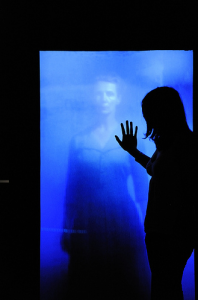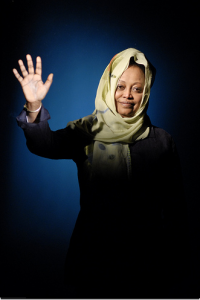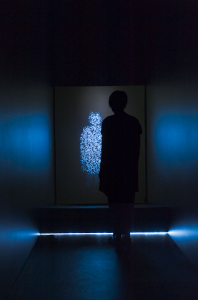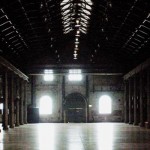PREFACE: I write to you from Sydney, Australia, my location for the next 6 months where I am trying my hand at a new adventure before pursuing my MA in Art History in the Fall. I am discovering a whole new art scene and deciphering a completely new national discourse. Below is my first Aussie review, a reflection on a show by Lynette Wallworth presented within the Sydney Festival. While both the exhibit and the festival are now over, Wallworth’s works were too good not to share. And the venue, CarriageWorks, will surely showcase some more intriguing and powerful work in the future.

At a time when technological innovations spring up more and more quickly and no one leaves home without their cell phone, some sort of android future seems imminent. There is hope, however, as there are a few select innovators, like Australian artist Lynette Wallworth, who mine technology for its humanizing qualities, using gadgets to enhance real sensual experiences. As part of Sydney Festival, Australia’s largest multi-disciplinary arts festival showcasing everything from music to dance to visual arts to theatre, three interactive video works by Lynette Wallworth were shown at CarriageWorks (a venue which is a work of art in itself, integrating modern spaces within an old railway factory). Within a pitch-black space, Wallworth has created immersive, interactive and intimate audio/visual environments that create profound experiential moments.
First, I came up and touched the screen of Invisible by Night (2004). My touch changed the pace of the video, the grief-stricken woman portrayed responded to my actions. I watched wondering what she would do next, fascinated. Created in response to the site of Melbourne’s first morgue, the video intends to comment on our neglect of ‘histories of site’ and our lack of acknowledgement of the grieving amongst us. I felt connected for a moment but, then, helpless, there was nothing I could do for this woman so full of emotion. She continued in her rhythm of mourning.

In the second work, The Evolution of Fearlessness (2006), I approached the screen and put my hand on the blue light. The figure of a woman emerged. She placed her hand on mine, stared at me a few moments and then retreated silently back into darkness. Each of the eleven women who appear is an immigrant to Australia who has experienced severe trauma in her life in another country (such as Afghanistan, Sudan, Iraq, etc.). A book alongside the exhibit tells each woman’s story of strength and survival (except one: “It is not safe to tell Shafiqa’s story at present”). The experience of the video thus gains a dimension: a simple gesture, a wordless interaction, the fragility and resilience of the human spirit. There is a simplicity and grace to Wallworth’s work that reflects its power and profundity.

One person at a time can experience the final piece, Duality of Light (2009). Alone, I was more confused than unequivocally inspired. I walked down a corridor to see a negative portrayal of myself, a figure human in shape, but filled with an abstract pattern. The multiple sounds along the way created a new sensation of space, but I left bewildered. Perhaps I was confronted with an odd experience, a technology that did not encourage me to lose myself but forced me to reconsider my self, my humanity, my identity.

Witnessing Wallworth’s work, it is no wonder that she is gaining international exposure through recent features at festivals and exhibits in England, France, as well as in New York and at Sundance just last year. Her art exists on a cutting edge that probes the way we live, the way we connect, the way we interact. I only hope Wallworth will continue to show her work worldwide as her intimate technological experiences deliver a potent, relevant and contemporary message about connection and humanity.






